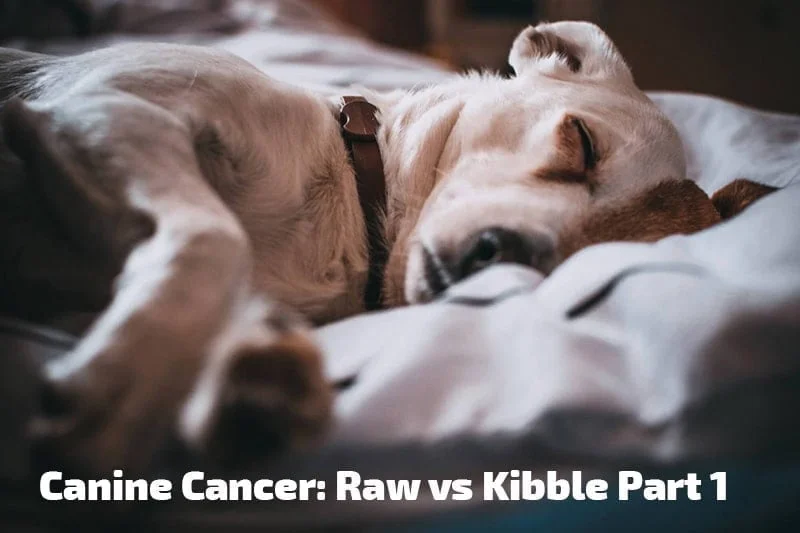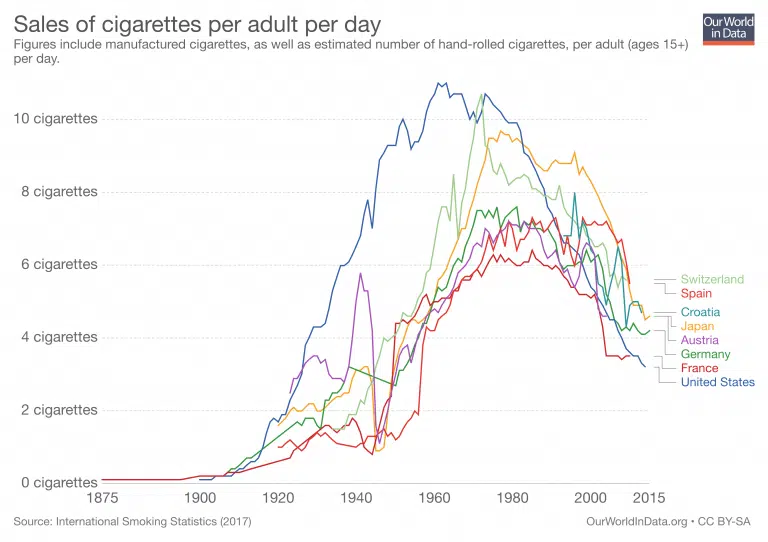The UK Kennel Club states on its website that ‘approximately 50% of deaths are cancer-related’. Most dogs eat tinned or dry kibbled food. Contrast this with the six thousand dog, 20-year, observational study of raw fed dogs by Thomas Sandberg in the USA. He claims that the death toll from cancer is, in these raw fed dogs, unbelievably, around three per cent.
In the USA over 1.66 million humans (approx. 500/100 000 population rate) and over 4.2 million dogs (approx. 5300/100 000 population rate) are diagnosed with cancer (Schiffman & Breen, 2014). This means that our dogs are over ten times more likely to get cancer than us.
How can this be possible? In this article, we investigate why dogs die more than three times more frequently of cancer than humans die of smoking and how natural raw dog food can help with cancer in dogs.
|
Tobacco smoking is one of the world’s largest health problems. It has been a major health problem for many decades. For the entire 20th century it is estimated that around 100 million people died prematurely because of smoking, most of them in rich countries. 1 The health burden of smoking is now shifting from high-income to low-to-middle income countries; some estimates have suggest that …
ourworldindata.org
|
What is so toxic in their world? More toxic than smoking?
The answer is all around us and our dogs… and within us. Dr Jean Dodds, in her book Nutrigenomics, states ‘that only 5% to 10% of all cancer cases originate from our genes. Everything else is the result of lifestyle and environmental factors, such as exposure to pollution, toxins, obesity, lack of physical activity, infection, stress and diet. These factors create ‘epigenetic’ changes. Epigenetic molecules turn off genes that suppress tumours and turn on cancer genes (Broad Institute, 2013). Many studies show that certain nutritional ingredients have epigenetic targets in cancer cells. These ingredients can defend against the development of many types of cancerous tumours or impact their progression. Astoundingly, scientists have concluded that 30% to 40% of all cancers can be prevented simply by implementing dietary changes (Anand et al., 2008; Divisi et al., 2006; Donaldson, 2004; Hardy & Tollefsbol, 2011; Ziech et al., 2010)’.
We have no direct control of our genes, but we can influence their expression, as Jean Dodds describes. You can reduce exposure to pollution by changing your household cleaning products and being careful where the dog swims, for example. Lack of physical activity is, possibly, one of the most straightforward factors to improve. Many of us would if we knew just how important it is to defend against cancer. Infection we all work hard to avoid, but beyond a wholesome routine and reasonable hygiene, we cannot eliminate it. Similarly, everyone is aware of stress and does their best to chill, but it’s usually easier said than done for our dogs and us.
Obesity and diet, on the other hand, are almost entirely in our control. And as the five scientific papers suggest, changing diet can make a massive difference in preventing cancers in the first place!
There are two primary routes for feeding your dog. The most common, the methods we’ve been using for the last 30 years is kibbled dried food. The Americans invented it in the 50s due to post-war rationing of metal and meat – tricky if you’re in the canned meat for dogs business! The result was ultra-processed dry food made with the cheapest of unwanted meats and lots and lots of low-cost grain. Result!
The fabled American housewife loved it for its convenience and lack of mess. Dogs? Well, they just got on with it because they were hungry and this was all that was going.
The other alternative is straightforward; you feed dogs as they have eaten before the industrialisation of food. You feed them what they have evolved to eat over millions of years and hundreds of thousands of generations. It is that simple; feed fresh raw food.
In Part 2, we discover why it is that dry kibble can catapult dogs up the statistical tables to be over three times more likely to die than smokers. Then read our final instalment, Part 3, to learn how raw is protective against cancer, not just because it offers an alternative to the biscuits of death, but because it allows the body to perform in every way, including fighting cancer optimally.
Dry Kibbled Food and Cancer
“Meat meal” powder is an ingredient in most dry cat food and dog food. It is made from abattoir and fish-processing factory remnants, inedible for humans. They are processed under high temperature and dehydrating the resulting pungent gloop into a dry powder for storage and transport. Meat meals eventually go into kibble as a cheap source of protein, allowing the manufacturer to claim meat content.
Compared to real meat, this product is much higher in ‘ash’, poorly digested minerals. Protein digestibility is 61% vs 95% in fresh meat. Lysine is an amino acid greatly affected by this production process. Essential in the body for immune function, calcium absorption and the formation of connective tissue collagen, in meat meal, available Lysine is 41g per kg protein, in real meat, about 65g/kg protein. Meat meal contains less available vitamins A, D and E, meaning synthetic vitamins must be added to kibble.
The major unregulated and unnecessary (yes, even nutrition textbooks agree) ingredient, is carbohydrate. It’s usually grain, but often maize, sweet potato or oats, depending on what’s fashionable and cheap. To these edifying building blocks is often added: Corn Gluten Meal, fruit & veg (sometimes and mostly powdered from China), preservatives, stabilisers, gelling agents, synthetic vitamins and minerals and palatability enhancers like yeast, fat, sweeteners or concentrated flavours. Now you know why we’re discussing kibble and cancer.
Because of the ingredients in kibble, the processing, storage and the repetitive feeding (one food for the whole life of the poor dog is typical), they can have a massive negative effect on canine health. If you examine a bowl of any given dried dog food, you won’t usually find high levels of toxins. If you study one cigarette, you won’t find much tar and nicotine. It’s the lifelong repetition of inferior quality ingredients and carcinogens that does the damage.
Ultra-processed food is a thing, a phenomenon. It even has a definition. Michael J. Gibney, in his 2019 paper on the subject, offers this most up to date definition: ‘Industrial formulations typically with five or more and usually many ingredients. Besides salt, sugar, oils, and fats, ingredients of ultra-processed foods include food substances not commonly used in culinary preparations, such as hydrolysed protein, modified starches, and hydrogenated or interesterified oils, and additives whose purpose is to imitate sensorial qualities of unprocessed or minimally processed foods and their culinary preparations or to disguise undesirable qualities of the final product, such as colourants, flavourings, non-sugar sweeteners, emulsifiers, humectants, sequestrants, and firming, bulking, de-foaming, anticaking, and glazing agents.’ I think you’ll agree that kibble most definitely comes under this definition.
And unfortunately, the 2015 paper by Luiten et al. says it all regarding the value and availability of the stuff. In their study, based in New Zealand, they state: ‘Ultra-processed foods have the worst nutrient profile, yet they are the most available packaged products in a sample of New Zealand supermarkets.’ The same is true, unfortunately in every country on earth.
8 Reason Kibble is So Bad for Cancer In Dogs
What are the mechanics of the harmful effects of kibble? Stick with us, and we’ll go through a list:
- Feeding a carnivore (or a very carnivorous omnivore, if you like) continuously on a high carb diet is madness. It distorts the gut microbiome, which responds to the inappropriate levels of carb and sugars in artificial food, corrupting the burning epicentre of every aspect of health.John Cryan in his book ‘Psychobiome’ went so far as to say, about the Gut-Brain connection that ‘If microbes are controlling the brain [from the gut], then microbes are controlling everything.’ Kibble changes the microbiome significantly, as documented in Milena Schmidt’s 2018 paper entitled ‘The faecal microbiome and metabolome differ between dogs fed Bones and Raw Food (BARF) diets and dogs fed commercial diets.’ Kiley Algya and her team studied this further, the same year, in their paper, ‘Apparent total-tract macronutrient digestibility, serum chemistry, urinalysis, and faecal characteristics, metabolites and microbiota of adult dogs fed extruded, mildly cooked, and raw diets.’They concluded, ‘Compared to the extruded diet, these diets had greater nutrient digestibility, resulted in reduced blood triglyceride concentrations, and shifted faecal microbiota populations and metabolite concentrations.’ A disturbed gut microbiome is associated with Irritable Bowel Syndrome (IBD) in humans and dogs. IBD is, in turn, a significant risk factor for colorectal cancer in humans. Few studies are available yet to establish the same link in dogs, but it’s likely to be similar.
- High Glycaemic index carbohydrates promote hyperinsulinemia (excess insulin production), which is associated with Type 2 diabetes, gout, Alzheimer’s disease, atherosclerosis and cancer in humans. In multiple studies, diabetes has been linked with increased risk of several types of cancers, including a three-times higher risk of colon-rectal cancer. (Anand et al., 2008; Divisi, 2006; Donaldson, 2004; Nahleh, Bhatti & Mal, 2011) From Nutrigenomics, byDr. Jean Dodds.
- Epigenetics, the molecules controlling how the body reads DNA, are very much influenced, for better and for worse by (raw and kibbled, respectively) food. For example, BHA, BHT and Ethoxyquin are carcinogenic preservatives long banned in the human food chain but are permitted in the UK pet food industry as EC permitted antioxidants E320, E321 and E324. They can all used in kibbled dog food dogs gets every day for an entire life stage or even for life.
- Overweight and obese dogs account for up to 70% of dogs in the UK and the USA. Obesity is very much influenced by the food you eat. We’re feeding dogs on high carb diets, a sure-fire recipe in humans for obesity. In humans, Jean Dodds’ Nutrigenomics, tells us: Breast, Cervical, Colon, Endometrial, Esophageal, Gastric, Gall bladder, Liver, Multiple myeloma, Non-Hodgkin’s lymphoma, Ovarian, Pancreatic, Rectal, Renal and Uterine cancers. Dogs don’t stand a chance! Incredibly, the response of veterinary nutritionists who advocate kibble feeding to control obesity is to “just control the amount that you feed”. Surely if it were this easy, we would not have gone from about 20% obesity in the ’80s, and 90’s to what we have today? They conveniently forget they advocate high carb daily for life and wonder why they have a 75% failure rate in slimming fat dogs.
- Counterintuitively, the work of Dr Mark Roberts on raw and kibble fed dogs shows that dogs on high carb diets have more elevated blood triglyceride (fat) levels than raw fed dogs on higher-fat diets! He argues this is why we see an increase in pancreatitis in the modern dog.Another study by Watson et al. in 2007 examined the pancreases of 200 dogs who had died from non-pancreatic disease. They found that 34% of the dogs showing no sign of pancreatitis at death had tissue changes indicative of long-term pancreatic disease. Cavaliers, Collies and Boxers were the main breeds affected in the study.If most of these dogs were likely to have been fed kibble, there seems a possibility that if you feed your dog kibble, you have a one in three chance of giving them pancreatic disease. Obesity is another factor contributing to pancreatitis. Long-term inflammation is a risk factor for cancer in any tissue.
- When you heat proteins, fats and sugars together, as you do when making kibble, carcinogens called Advanced Glycation End-products (AGEs) are made. These toxins are a bio-marker implicated in humans in ageing and the development or worsening, of many degenerative diseases, such as diabetes, atherosclerosis, chronic kidney disease, Alzheimer’s disease and cancers.
- An independent laboratory test of dry dog foods commissioned by the Environmental Working Group (EWG) found that eight out of 10 major US brands sold for puppies and adults contained fluoride. Levels were discovered between 1.6 and 2.5 times higher than the US Environmental Protection Agency’s maximum legal dose in drinking water. The foods all included a bone meal, meat meal or meat by-product meal. Fluoride in bones is considered a risk factor for Osteosarcoma, a terrible bone cancer that mainly affects the long bones of large breed dogs. Boxer Dogs, Doberman Pinschers, Golden Retrievers, German Shepherd Dogs, Great Danes, Great Pyrenees, Greyhounds, Irish Setters, Irish Wolfhounds, Labrador Retrievers, Rottweilers, Saint Bernards, and Weimaraners are the breeds most affected by this cruel disease.
- Periodontal disease is prevalent in the kibble eating population. Experience, common sense and studies confirm this. Marx et al. in 2016 looked at beagles chewing bones. They concluded, ‘Chewing raw bovine bones was an effective method of removing dental calculus in dogs.’ In 2012, Rene Carlson, then President of the AVMA stated, ‘It’s estimated that by the age of two, 80 per cent of dogs and 70 per cent of cats have some form of periodontal disease.’ Dr. Tom Lonsdale, in his landmark 2001 book ‘Raw Meaty Bones Promote Health’, describes how periodontal disease causes inflammation and damage to the gum margin leading to bacterial endotoxins, cytokines and free radicals entering the bloodstream to pollute the whole body. He quotes Stohl on free radicals: ‘Oxidative stress associated with the production of reactive oxygen species is believed to be involved not only in the toxicity of xenobiotics [foreign chemicals] but also in the pathophysiology of ageing, and various age-related diseases, including cataracts, atherosclerosis, neoplastic diseases [cancer], diabetes, diabetic retinopathy, chronic inflammatory diseases of the gastrointestinal tract, ageing of the skin, diseases associated with cartilage, Alzheimer’s disease and other neurological disorders.’
5 Reasons Raw Food Helps Protect Against Cancer
Kibble, as we have discussed, is associated with bowel cancer via microbiome disruption and IBD. It can promote cancer through chronic high blood insulin, toxic additives, obesity, chronic inflammation in the pancreas and bowel, high-temperature carcinogens, high levels of fluoride and periodontal disease. Appropriately fed raw food has none of these risks. Also, it offers protective factors:
- Raw diets are more ketogenic (inducing the body to use ketones in the blood for fuel in preference to glucose) than high carb kibbles. An every-day raw food meal can be easily made more ketogenic by stripping back vegetables to a bare minimum and adding more fat. This is precisely what they do at the Ketopet Sanctuary in Texas. Founded in 2014, they set out to give rescue dogs with cancer in shelters a ‘forever home’. The dogs were put on a ketogenic diet and their progress monitored by examination, blood work and PET (positron emission tomography) scanning, a bit like an MRI-type scan. Tumour size and distribution were observed. As you can see on their website, their numerous case studies show much-improved outcomes for many cancers using this nutrition-led approach.
- Most raw diets contain herbs and plant material with anti-cancer properties. Mohammad Aghajanpour and his team at Lorestan University of Medical Sciences, Khorramabad, Iran published a fantastic paper called ‘Functional foods and their role in cancer prevention and health promotion: a comprehensive review.’ In it, they detail a dozen well-researched molecules commonly found in plants. For example, Lutein is found in dark green leafy vegetables. It is a potent antioxidant. It is efficient in cell cycle progression and can inhibit the growth of several cancer cell types. Herbs including turmeric, milk thistle, Siberian ginseng and Reishi mushroom are among thousands of plants that have well researched anti-cancer effects. A 2005 study of 92 Scottish Terriers suggests that consuming certain vegetables might prevent or slow the development of transitional cell carcinoma (TCC) (bladder cancer) in this breed. The study compared the 92 Scottish Terriers older than six years who suffered from TCC with 83 Scottish Terriers who had no recent history of urinary tract disease. Scotties eating vegetables at least three times per week showed a 40-70% reduction in risk of developing the disease (Raghavan et al., 2005).
- Omega-3 fatty acids are generally low in the typical human and dog Western diet. Addition of fresh, non-rancid, fish, krill or flax oil is common in raw diets. They have a powerful anti-inflammatory effect. In humans, they are protective against breast and prostatic cancers.
- Bacterial contamination in raw food is a thorny issue. The critics of raw point out the many bacteria found routinely in raw food. Defenders of raw feeding are equally quick to point out the vanishingly small number of cases where dogs have been injured through infection. This is not surprising if we consider dogs have been eating rotting carcases, herbivore intestinal contents and faeces for hundreds of thousands of years. Indeed, it is logical to think this low level of bacterial ‘contamination’ is possibly where raw food is superior to the more sterile tins and kibbles promoted by food corporations. We see raw fed dogs with much better gut function, in many cases, than those eating the ultra-hygienic processed factory foods. Superior gut function means reduced inflammation which in turn reduces the risk of cancer.
Although no diet can guarantee to avoid cancer, it seems, unsurprisingly, that Mother Nature knows best. Feeding a species-appropriate diet not only prevents the pitfalls of ultra-processed food, but it also confers protection against the most common modern killer of dogs, cancer.







0 comments